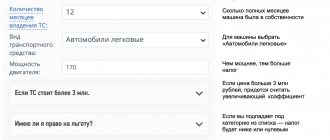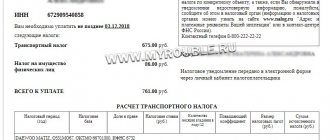In connection with numerous discussions on the topic of the financial burden borne by the owners of heavy vehicles, starting in November 2015, questions related to the abolition or change of the procedure for calculating transport tax on trucks are constantly being raised.
Next, we will look at how the duty on freight transport is calculated in 2021 and whether the transport tax for heavy trucks has been abolished.
An advantageous offer from the partners of our portal - Terem Loan! Apply for a loan in the amount of up to 30 thousand rubles for a period of up to 30 days.
100% approval!
Get money
Transport tax on trucks in 2021
Transport tax is paid according to the rules established by the Tax Code of the Russian Federation (Chapter 28, Article 356) on the basis of the basic (state) rate. In this case, the purpose of the payment is to replenish regional budgets. Consequently, the transport tax for each region is approved at the legislative level of the constituent entities of the Russian Federation and is a mandatory payment for each car owner ( Chapter 28, Article 357 of the Tax Code of the Russian Federation ).
The tax period is the reporting year. Tax rates, determined by laws at the regional level, can be increased or decreased in relation to the base (state) rate. Their size is influenced by:
- engine power , measured in horsepower.
- Gross tonnage.
- Vehicle category.
- Year of car manufacture.
Moreover, in each subject of the Russian Federation and cities of administrative significance, the authorities determine who can use transport benefits.
Vehicles belong to different groups according to category and type (this information is in the registration certificate).
Car categories are divided into five groups:
- Motor transport (“A”).
- Passenger cars with a weight of no more than 3.5 tons and a number of passenger seats of no more than 8 (“B”) .
- Vehicles weighing more than 3.5 tons (“C”).
- Vehicles with passenger seats (“D”) .
- Trailers designed to travel with a vehicle (“E”) .
Each category and type of vehicle has its own rates. Tariffs for freight and passenger transport may differ several times.
All-Russian base rates for transport taxes on heavy trucks
In 2021, the transport tax rate remains unchanged . The abolition of this category of payments is not envisaged, since it is one of the most significant sources of financial revenue to the state budget.
In each subject of the Russian Federation, the transport tax on trucks is calculated independently, however, there are all-Russian state rates (basic), which are based on engine power, which is measured in horsepower. At the same time, the amount of the transport tax, which is charged in 2021 in the regions, may differ from the state level (increasing or decreasing) by no more than 10 times (Chapter 28, Article 361 of the Tax Code of the Russian Federation) in relation to various categories of cars and their age , ecological class.
For each horsepower of trucks, the following base rate is established, measured in rubles ( Chapter 28, Article 361 of the Tax Code of the Russian Federation ):
- up to 100 hp - 2.5;
- from 100 to 150 hp - 4;
- 150-200 hp - 5;
- over 250 hp — 6.5 .
The tax amount established for each region can be viewed on the official website of the Federal Tax Service.
In order to find out the amount of tax on freight transport today, it is enough to know the engine power, measured in horsepower.
Platonic relationships
The government decree on increasing the fare for foreigners was signed by Russian Prime Minister Dmitry Medvedev. The price was raised from 385 to 850 rubles per day, from 60 to 120 thousand rubles per year.
In addition, the list of countries whose citizens must pay for travel has been expanded. Now there are Latvia and Lithuania. This is a response measure, since the Baltic republics have already introduced a fee for our trucks, Deputy General Director of the Association of International Road Carriers (ASMAP) Petr Pavlyuk told Rossiyskaya Gazeta.
Almost throughout Europe, Russian freight carriers pay for travel on federal roads. The cost of one kilometer differs not only from country to country, but also depends on the class of the engine (the more environmentally friendly, the lower the fee). The tariff can range from 11 to 22 eurocentres per kilometer. That is, at least 8 rubles.
If we take the new tariffs for foreigners, which are set by our government, we get from 2 to 3 rubles per kilometer. Not so much compared to the tariffs of other countries. But these funds will also be very useful, because they will go to the Road Fund, and therefore to the implementation of large transport projects.
As for Russian owners of trucks weighing over 12 tons, the Ministry of Transport has provided benefits for them - we are talking about zeroing out the transport tax until 2021. A bill on this has already been submitted to the State Duma.
But there is a nuance. It will be possible to “forget” about the tax payment only if the truck drives along federal highways for a larger amount than the tax itself. To prove this, carriers will have to come to the tax office and present their payments that they made within the Platon system, explained Mikhail Blinkin, director of the Institute of Transport Economics and Transport Policy at the Higher School of Economics.
It is expected that this tax preference will be applied to organizations from January 1, 2021, and for individuals from January 1, 2015.
Currently, the transport tax depends on the horsepower of the engine and the decision of the region, which sets its size. The amount of tax for 12-ton trucks can range from 25 to 45 thousand rubles, Valery Voitko, coordinator of the Trucker Association, clarified in a conversation with RG. And in a year, the owner of a truck can drive on Russian roads in the amount of 100 to 150 thousand rubles, he estimated. So if the bill passes, the savings will be significant.
Trucks drive not only on federal, but also on regional highways. There, the load on the road is tens of times greater, and the roads need to be constantly “brought to life.” And if previously the regions repaired them using revenues from transport taxes, now it has been decided to finance their modernization directly from the federal budget.
The Cabinet of Ministers has already allocated 34.16 billion rubles for these purposes this year, which will be distributed among 78 regions of the country.
Another 18.39 billion rubles will go to large and socially significant road projects that will increase the capacity of the regional and local road network. 27 entities will receive funds from this amount.
In total, the federal budget for 2021 provides for interbudgetary transfers for road projects in the amount of 84.19 billion rubles.
There will be cameras everywhere
The government has submitted to the State Duma draft amendments to the Law “On Highways and Road Activities in the Russian Federation.” According to these amendments, automatic cameras will become one of the elements of the road along with road signs and bump stops. True, not all cameras are automatic, but only those that work in the Platon system, that is, they charge for the passage of 12-ton trucks.
However, cameras also recorded photo and video violations. It is proposed to oblige railway track owners to equip all crossings with automatic systems for recording violations. And these complexes will also become an additional element of the road.
This was done as part of the government action plan aimed at reducing road deaths. Cameras for photo and video recording of violations have already shown their effectiveness in reducing speed on dangerous sections of roads. As a result, the accident rate on them has decreased significantly. And the accident rate at railway crossings is growing.
Yes, the numbers here are not very significant, but these are someone’s lives. Thus, in the first quarter of this year, 61 accidents occurred at railway crossings. 20 people died in them. Last year there were 55 such accidents in the 1st quarter. 15 people died in them. At the same time, in the first quarter in the Moscow region alone, already operating photo-video recording systems identified more than 600 violations of crossing rules.
Prepared by Vladimir Barshev
Are all types of freight transport subject to taxation?
Transport tax is charged on all types of heavy equipment that is used to transport cargo : dump trucks , vans , platforms, tractors, multi-axle trucks, small vehicles and light-duty vehicles, pickups .
If the transport is used to perform agricultural or other specialized work, then the transport tax is not charged. Such vehicles include milk tankers , vehicles for transporting fertilizers , poultry , livestock , special vehicles for veterinary services , self-propelled vehicles , tractors , combines , etc. ( Chapter 28, Article 358 of the Tax Code of the Russian Federation ).
Transport duty is not charged on these types of machines only if the owner is a registered manufacturer of agricultural products.
Nuances of calculating tax on freight transport category “B”
The greatest uncertainty for car owners is the tax on flatbed cargo vehicles of category “B” (pick-ups) and on vehicles of the “ van ” vehicle type ( minibuses ), also belonging to category “B”.
Assuming that the letter “ B ” indicated in the PTS in the line “ Vehicle Category ” indicates that the car belongs to the category of passenger vehicles, the owner of such a car is surprised to receive a notification from the Federal Tax Service, in which the transport tax rate is calculated as for freight transport. As a rule, this rate is several times higher than for a passenger car. And this is not a mistake of the tax authorities, since the transport tax is calculated based on the rate, which is determined not by category “ B ”, but by the type of vehicle.
Category “ B ” only indicates that the following vehicles are permitted:
- maximum vehicle weight – no more than 3.5 tons;
- number of passenger seats – no more than 8 .
These restrictions precisely indicate category “ B ” in accordance with the Regulations on vehicle passports and vehicle chassis passports, approved. Order of the Ministry of Internal Affairs of Russia N 496, Ministry of Industry and Energy of Russia N 192 , Ministry of Economic Development of Russia N 134 of June 23, 2005 (clause 28) and Appendix 6 to the Convention on Road Traffic (clause 5) .
Thus, we can conclude:
- Category “B” is not always a passenger car . Trucks that fall under the specified criteria may also be included in this category.
- When it comes to determining the type of car, you cannot focus on category “B” .
Benefits for participants of the Platon system
Platon system was introduced in Russia ( Federal Law No. 68-FZ of 04/06/2011 ), which provides for the obligation to pay a toll when driving on federal roads of vehicles with a permissible maximum weight of over 12 tons . Truck owners are faced with a significant financial burden in the form of two mandatory payments with the same purpose: financing roads intended for public use.
Subsequently, in order to reduce this burden, Federal Law No. 249-FZ dated July 3, 2016 amended the second part of the Tax Code of the Russian Federation. The amendments provide for adjustments to the taxation system for owners of freight vehicles with a permissible maximum weight of more than 12 tons.
In accordance with Article 1 of Federal Law No. 249-FZ dated July 3, 2016 “On Amendments to Part Two of the Tax Code of the Russian Federation,” Platon toll collection system :
- If the amount of payment made under the “ Platon ” system is equal to or exceeds the amount of the accrued tax on a cargo vehicle, then the owner is exempt from paying this tax .
- If the amount of payment under the “ Plato ” system is less than the amount of tax, then the car owner is entitled to a tax deduction equal to the amount of payment made.
It is important that the transport tax benefit is provided to the owner of a freight transport - a participant in the Platon , regardless of who owns the truck: an individual or an individual entrepreneur. This is explained by the fact that when calculating transport tax, individual entrepreneurs are equated to individuals ( Chapter 28, Article 362 of the Tax Code of the Russian Federation ), since there is no special procedure for paying transport tax for taxpayers who are individual entrepreneurs.
The benefit is provided to owners of large cargo for each truck that has been registered in the Platon system
It should be borne in mind that this benefit is provided for legal relations established from January 1, 2021 - for organizations, from January 1, 2015 - for individuals. The law extends its effect until January 1, 2021 .
You can apply for a transport tax benefit in one of the following ways:
- Contact the tax office in person.
- Use the services of Russian Post .
- Leave an application on the Federal Tax Service website in the taxpayer’s personal account.
Transport tax and Plato
Truck owners are the main source of budget revenue for taxes directly related to transport. Such fees include not only the transport tax, but also the “payment per ton” in the Plato system. The latter type of tax is not paid by all truck owners - it applies only to those who own a vehicle weighing more than 12 tons.
The Plato system appeared not so long ago. After its implementation, changes were made to the tax code. Yes, Art. 361.1 of the Tax Code of the Russian Federation contains information about the possibility of reducing transport tax or completely exempting it for cars whose weight exceeds 12 tons. We are talking about the following benefits:
- you don’t have to pay the tax at all if the “payment per ton” turns out to be higher than or equal to the amount of the transport fee;
- the amount of the penalty may be reduced if the fees paid in the Plato system turned out to be lower than the transport tax.
At the same time, the right to these benefits for trucks arises only if their weight exceeds 12 tons (trucks up to 12 tons are not valid), the vehicle is included in the Plato system, and its owner pays the appropriate funds to the treasury. Then the benefit is calculated using the following formula:
Transport tax payable = Amount of accrued transport tax – Amounts paid through the Platon system
It is noteworthy that the amounts contributed must relate to the same tax period and relate exclusively to the same vehicle.
If the value turns out to be negative, you will not be able to get the money back - simply the entire amount of the transport tax will be written off. To receive such a benefit, you must present documents to the Federal Tax Service indicating payment of contributions in the Platon system.
Rules and procedure for paying transport tax
The payer of transport tax on freight transport, as in the case of passenger cars, is the owner in whose name the vehicle is registered.
A truck can be registered to an individual or a company (organization, institution).
Payment of transport tax is made by the car owner after receiving the appropriate notification sent by the tax office 30 days before the date of payment to the address that the car owner indicated when registering the vehicle.
The absence of a postal tax notice is not grounds for exemption from payment of the transport tax. If there is no such notice, you should contact the tax office to find out the reasons and receive a tax receipt in person.
If payment of transport tax is not made within the deadlines established by law, then this may be considered a tax, administrative offense or even a criminal offense . In case of tax evasion (including transport tax), enforcement measures are provided.
In accordance with Art. 45 Part 2 of the Tax Code of the Russian Federation, debt is collected in the manner prescribed by Articles 46,47,48 of the Tax Code of the Russian Federation :
- The car owner-taxpayer is notified of the need to pay the debt and penalties for each overdue day.
- Tax authorities file a claim in court , which may decide to collect transport tax by:
- writing off funds (electronic or from bank accounts);
- seizure of property.
For physical individuals, tax can be collected by deducting the required amount from wages. In addition, the defaulter’s travel outside the Russian Federation may be limited.
Article 15.5 of the Code of Administrative Offenses of the Russian Federation provides for administrative punishment for late provision of tax information (declarations, calculations of insurance premiums): a warning or a fine for officials.
If the car owner, evading paying tax, did not report the purchased vehicle to the Federal Tax Service (hid tax information), then the measures provided for in Art. 198 of the Criminal Code of the Russian Federation : fine, forced labor, arrest, imprisonment. For organizations, such measures are provided for in Art. 199 of the Criminal Code of the Russian Federation .
In this regard, car owners (individual, individual entrepreneur or organization) must be personally interested in promptly reporting information about the vehicle to the Federal Tax Service and paying the transport tax on a car (including a truck) on time and in full.
Do I have to pay for a truck?
According to Art. 358 of the Tax Code of the Russian Federation, cars (including trucks) fall under the concept of the object of payment of transport tax. That’s why truck owners pay this fee on an equal basis with everyone else. However, in comparison with the transport tax on passenger cars, a number of features can be highlighted here:
- the increasing factor does not apply to trucks, regardless of their cost (the luxury tax applies only to passenger cars);
- transport tax on trucks over 12 tons may not be paid or may be reduced if the vehicle participates in the Plato system;
- Depending on the power, the tax rate for trucks may be different, but it is different from the rates for cars.
There is no point in talking about a tax on trucks up to 3.5 tons, since the Russian classification implies that the weight of trucks starts from just 3.5 tons. But Class D passenger cars with this weight are not classified as freight cars, so you will have to pay tax on them as for a passenger car.









